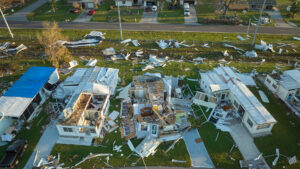This article represents the opinion of the Tampa Bay Times Editorial Board.
Hurricanes are a fact of life in Florida. Even so, some of those facts are slow to sink in. There are red flags everywhere: Many of our most densely populated communities are adjacent to the ocean or the gulf. We keep building in the most storm-prone areas. We haven’t done enough to fortify coastal areas against sea-level rise. And affordable property insurance could be added to the endangered species list. Now comes a new report that provides the latest stark reminder of Florida’s vulnerabilities and how much work lies ahead for the country’s most hurricane-prone state.
Just how vulnerable? The 20 U.S. cities most in danger of getting smacked by a major hurricane in the next decades are all in Florida. That’s a lot of risk, to state the obvious. The analysis from the nonprofit First Street Foundation, released recently and reported on by The Washington Post, also found that Florida will account for about $7 out of every $10 in hurricane damage. It’s no wonder that actuaries get cross-eyed looking at Florida’s property insurance risk. Those numbers also go a long way to explaining why it would be naive to expect property insurance rates in Florida’s coastal counties to tumble anytime soon.
The First Street report also showed how climate change will push hurricane force winds farther inland, not just in Florida but in places like Arkansas and Tennessee. And as we know by Florida’s ever-growing population, people aren’t moving away from the risk. The Post, in fact, found that people are moving to counties categorized as high risk for hurricane-force winds at six times the rate of other counties. That’s all the more reason for people and places to get prepared. The storms are coming. Be ready.

Part of being ready is encouraging our elected officials to address the tough question about where to keep building and how to build. Getting into the specifics would require more space than this editorial allows, but Hurricane Ian last year provided some solid examples of how stronger building codes and better planning can help protect homes and other buildings from wind and floods. The conversation must grow louder. Will we allow for more density in coastal high-hazard areas? How much should we rebuild on barrier islands? After all, they are called “barriers” for a reason. Can we build even stronger buildings, and should we?
It’s easy to scream “retreat!” but most Florida residents live within 20 miles of the coast. More than 40% of St. Petersburg is in the coastal high-hazard area. Where would everyone go? Pulling back from the most vulnerable areas must be part of the overall strategy, but it’s unrealistic to think coastal communities will just close up shop. Skyrocketing property insurance rates will change some minds. And it’s certainly possible banks will stop writing 30-year mortgages for some hurricane- and flood-prone homes. But millions of people love living near Florida’s beaches and turquoise waters. That’s unlikely to change anytime soon.
It’s easy to become inured to hurricane risks. For Florida, the challenge is so massive as to seem intractable. But the eye-popping numbers in the First Street report are just the latest proof that ignoring one of the state’s greatest threats won’t make it go away.
This editorial was originally published by the Tampa Bay Times, which is a media partner of The Invading Sea. Editorials are the institutional voice of the Tampa Bay Times. The members of the Editorial Board are Editor of Editorials Graham Brink, Sherri Day, Sebastian Dortch, John Hill, Jim Verhulst and Chairman and CEO Conan Gallaty. Follow @TBTimes_Opinion on Twitter for more opinion news.



